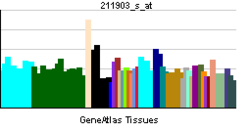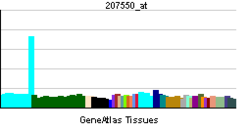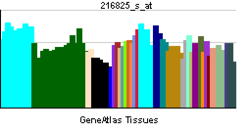- Thrombopoietin receptor
-
Myeloproliferative leukemia virus oncogene Identifiers Symbols MPL; C-MPL; CD110; MPLV; TPOR External IDs OMIM: 159530 MGI: 97076 HomoloGene: 7845 GeneCards: MPL Gene Gene Ontology Molecular function • transmembrane receptor activity
• cytokine receptor activityCellular component • plasma membrane
• plasma membrane
• integral to plasma membraneBiological process • cell surface receptor linked signaling pathway
• blood coagulation
• cell proliferation
• platelet activationSources: Amigo / QuickGO RNA expression pattern 


More reference expression data Orthologs Species Human Mouse Entrez 4352 17480 Ensembl ENSG00000117400 ENSMUSG00000006389 UniProt P40238 Q3ZB69 RefSeq (mRNA) NM_005373 NM_010823 RefSeq (protein) NP_005364 NP_034953 Location (UCSC) Chr 1:
43.8 – 43.82 MbChr 4:
118.12 – 118.13 MbPubMed search [1] [2] Myeloproliferative leukemia virus oncogene (MPL) also known as CD110 (Cluster of Differentiation 110), is a human gene.[1]
In 1990 an oncogene, v-mpl, was identified from the murine myeloproliferative leukemia virus that was capable of immortalizing bone marrow hematopoietic cells from different lineages. In 1992 the human homologue, named, c-mpl, was cloned. Sequence data revealed that c-mpl encoded a protein that was homologous with members of the hematopoietic receptor superfamily. Presence of anti-sense oligodeoxynucleotides of c-mpl inhibited megakaryocyte colony formation. The ligand for c-mpl, thrombopoietin, was cloned in 1994. Thrombopoietin was shown to be the major regulator of megakaryocytopoiesis and platelet formation. The protein encoded by the c-mpl gene, CD110, is a 635 amino acid transmembrane domain, with two extracellular cytokine receptor domains and two intracellular cytokine receptor box motifs . TPO-R deficient mice were severely thrombocytopenic, emphasizing the important role of CD110 and thrombopoietin in megakaryocyte and platelet formation. Upon binding of thrombopoietin CD110 is dimerized and the JAK family of non-receptor tyrosine kinases, as well as the STAT family, the MAPK family, the adaptor protein Shc and the receptors themselves become tyrosine phosphorylated.[1]
Contents
Interactions
Myeloproliferative leukemia virus oncogene has been shown to interact with ATXN2L.[2]
See also
References
- ^ a b "Entrez Gene: MPL myeloproliferative leukemia virus oncogene". http://www.ncbi.nlm.nih.gov/sites/entrez?Db=gene&Cmd=ShowDetailView&TermToSearch=4352.
- ^ Meunier, Caroline; Bordereaux Didier, Porteu Francoise, Gisselbrecht Sylvie, Chrétien Stany, Courtois Geneviève (Mar. 2002). "Cloning and characterization of a family of proteins associated with Mpl". J. Biol. Chem. (United States) 277 (11): 9139–47. doi:10.1074/jbc.M105970200. ISSN 0021-9258. PMID 11784712.
Further reading
- Kato T, Matsumoto A, Ogami K, et al. (1999). "Native thrombopoietin: structure and function.". Stem Cells 16 (5): 322–8. doi:10.1002/stem.160322. PMID 9766811.
- Vigon I, Mornon JP, Cocault L, et al. (1992). "Molecular cloning and characterization of MPL, the human homolog of the v-mpl oncogene: identification of a member of the hematopoietic growth factor receptor superfamily.". Proc. Natl. Acad. Sci. U.S.A. 89 (12): 5640–4. doi:10.1073/pnas.89.12.5640. PMC 49348. PMID 1608974. http://www.pubmedcentral.nih.gov/articlerender.fcgi?tool=pmcentrez&artid=49348.
- Souyri M, Vigon I, Penciolelli JF, et al. (1991). "A putative truncated cytokine receptor gene transduced by the myeloproliferative leukemia virus immortalizes hematopoietic progenitors.". Cell 63 (6): 1137–47. doi:10.1016/0092-8674(90)90410-G. PMID 2175677.
- Le Coniat M, Souyri M, Vigon I, et al. (1989). "The human homolog of the myeloproliferative virus maps to chromosome band 1p34.". Hum. Genet. 83 (2): 194–6. doi:10.1007/BF00286717. PMID 2550356.
- Drachman JG, Griffin JD, Kaushansky K (1995). "The c-Mpl ligand (thrombopoietin) stimulates tyrosine phosphorylation of Jak2, Shc, and c-Mpl.". J. Biol. Chem. 270 (10): 4979–82. doi:10.1074/jbc.270.10.4979. PMID 7534285.
- Mignotte V, Vigon I, Boucher de Crèvecoeur E, et al. (1994). "Structure and transcription of the human c-mpl gene (MPL).". Genomics 20 (1): 5–12. doi:10.1006/geno.1994.1120. PMID 8020956.
- Mu SX, Xia M, Elliott G, et al. (1996). "Megakaryocyte growth and development factor and interleukin-3 induce patterns of protein-tyrosine phosphorylation that correlate with dominant differentiation over proliferation of mpl-transfected 32D cells.". Blood 86 (12): 4532–43. PMID 8541543.
- Deveaux S, Filipe A, Lemarchandel V, et al. (1996). "Analysis of the thrombopoietin receptor (MPL) promoter implicates GATA and Ets proteins in the coregulation of megakaryocyte-specific genes.". Blood 87 (11): 4678–85. PMID 8639837.
- Drachman JG, Kaushansky K (1997). "Dissecting the thrombopoietin receptor: functional elements of the Mpl cytoplasmic domain.". Proc. Natl. Acad. Sci. U.S.A. 94 (6): 2350–5. doi:10.1073/pnas.94.6.2350. PMC 20091. PMID 9122198. http://www.pubmedcentral.nih.gov/articlerender.fcgi?tool=pmcentrez&artid=20091.
- Ihara K, Ishii E, Eguchi M, et al. (1999). "Identification of mutations in the c-mpl gene in congenital amegakaryocytic thrombocytopenia.". Proc. Natl. Acad. Sci. U.S.A. 96 (6): 3132–6. doi:10.1073/pnas.96.6.3132. PMC 15907. PMID 10077649. http://www.pubmedcentral.nih.gov/articlerender.fcgi?tool=pmcentrez&artid=15907.
- Drachman JG, Millett KM, Kaushansky K (1999). "Thrombopoietin signal transduction requires functional JAK2, not TYK2.". J. Biol. Chem. 274 (19): 13480–4. doi:10.1074/jbc.274.19.13480. PMID 10224114.
- Cargill M, Altshuler D, Ireland J, et al. (1999). "Characterization of single-nucleotide polymorphisms in coding regions of human genes.". Nat. Genet. 22 (3): 231–8. doi:10.1038/10290. PMID 10391209.
- Okabe S, Tauchi T, Morita H, et al. (1999). "Thrombopoietin induces an SH2-containing protein, CIS1, which binds to Mpl: involvement of the ubiquitin proteosome pathway.". Exp. Hematol. 27 (10): 1542–7. doi:10.1016/S0301-472X(99)00094-6. PMID 10517496.
- Miyakawa Y, Drachman JG, Gallis B, et al. (2000). "A structure-function analysis of serine/threonine phosphorylation of the thrombopoietin receptor, c-Mpl.". J. Biol. Chem. 275 (41): 32214–9. doi:10.1074/jbc.M005080200. PMID 10918061.
- van den Oudenrijn S, Bruin M, Folman CC, et al. (2000). "Mutations in the thrombopoietin receptor, Mpl, in children with congenital amegakaryocytic thrombocytopenia.". Br. J. Haematol. 110 (2): 441–8. doi:10.1046/j.1365-2141.2000.02175.x. PMID 10971406.
- Wang Q, Miyakawa Y, Fox N, Kaushansky K (2000). "Interferon-alpha directly represses megakaryopoiesis by inhibiting thrombopoietin-induced signaling through induction of SOCS-1.". Blood 96 (6): 2093–9. PMID 10979953.
- Miyakawa Y, Rojnuckarin P, Habib T, Kaushansky K (2001). "Thrombopoietin induces phosphoinositol 3-kinase activation through SHP2, Gab, and insulin receptor substrate proteins in BAF3 cells and primary murine megakaryocytes.". J. Biol. Chem. 276 (4): 2494–502. doi:10.1074/jbc.M002633200. PMID 11054408.
- Tonelli R, Scardovi AL, Pession A, et al. (2000). "Compound heterozygosity for two different amino-acid substitution mutations in the thrombopoietin receptor (c-mpl gene) in congenital amegakaryocytic thrombocytopenia (CAMT).". Hum. Genet. 107 (3): 225–33. doi:10.1007/s004390000357. PMID 11071383.
- Ballmaier M, Germeshausen M, Schulze H, et al. (2001). "c-mpl mutations are the cause of congenital amegakaryocytic thrombocytopenia.". Blood 97 (1): 139–46. doi:10.1182/blood.V97.1.139. PMID 11133753.
External links
This article incorporates text from the United States National Library of Medicine, which is in the public domain.
Cytokine receptors Chemokine receptor
(GPCRs)OtherTNF receptor 1-1011-2021-25JAK-STAT OtherIg superfamily IL-17 family S/T B trdu: iter (nrpl/grfl/cytl/horl), csrc (lgic, enzr, gprc, igsr, intg, nrpr/grfr/cytr), itra (adap, gbpr, mapk), calc, lipd; path (hedp, wntp, tgfp+mapp, notp, jakp, fsap, hipp, tlrp) 
This membrane protein-related article is a stub. You can help Wikipedia by expanding it.
